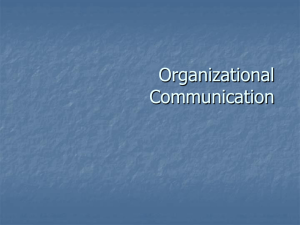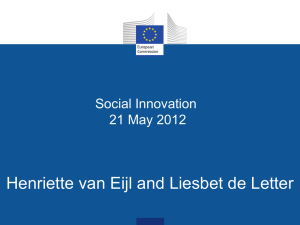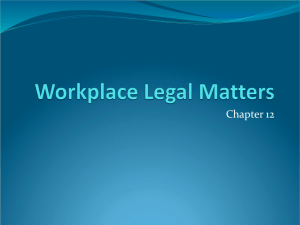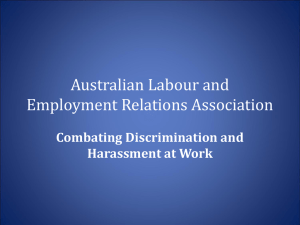Workplace Diversity and Inclusion Strategy 2011-15
advertisement
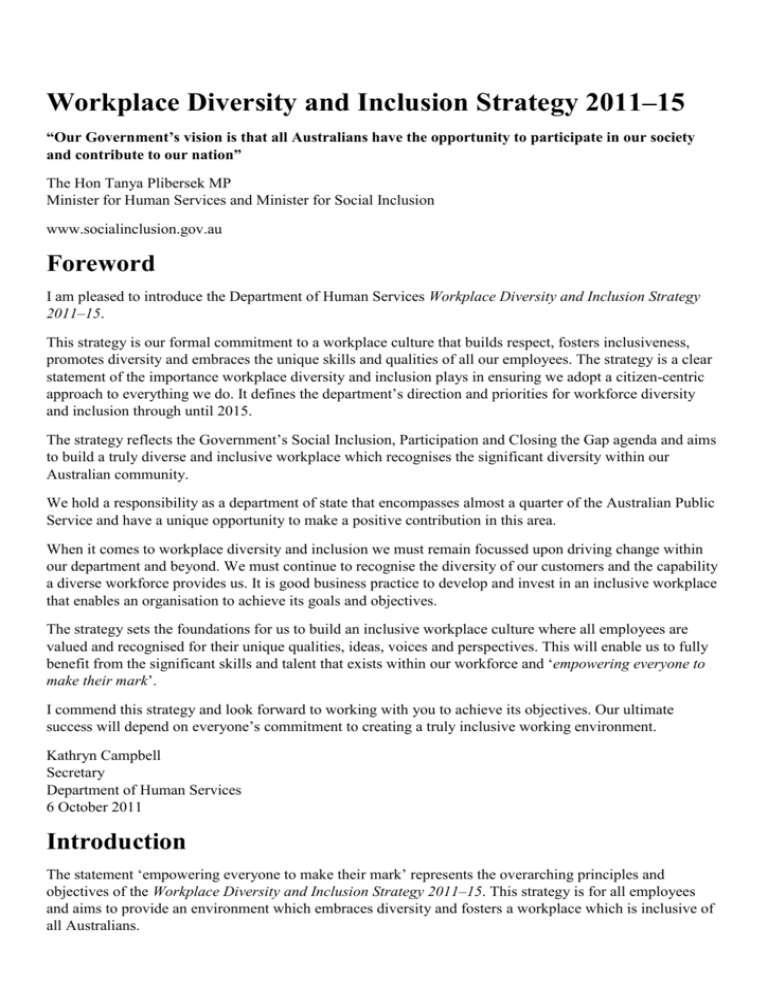
Workplace Diversity and Inclusion Strategy 2011–15 “Our Government’s vision is that all Australians have the opportunity to participate in our society and contribute to our nation” The Hon Tanya Plibersek MP Minister for Human Services and Minister for Social Inclusion www.socialinclusion.gov.au Foreword I am pleased to introduce the Department of Human Services Workplace Diversity and Inclusion Strategy 2011–15. This strategy is our formal commitment to a workplace culture that builds respect, fosters inclusiveness, promotes diversity and embraces the unique skills and qualities of all our employees. The strategy is a clear statement of the importance workplace diversity and inclusion plays in ensuring we adopt a citizen-centric approach to everything we do. It defines the department’s direction and priorities for workforce diversity and inclusion through until 2015. The strategy reflects the Government’s Social Inclusion, Participation and Closing the Gap agenda and aims to build a truly diverse and inclusive workplace which recognises the significant diversity within our Australian community. We hold a responsibility as a department of state that encompasses almost a quarter of the Australian Public Service and have a unique opportunity to make a positive contribution in this area. When it comes to workplace diversity and inclusion we must remain focussed upon driving change within our department and beyond. We must continue to recognise the diversity of our customers and the capability a diverse workforce provides us. It is good business practice to develop and invest in an inclusive workplace that enables an organisation to achieve its goals and objectives. The strategy sets the foundations for us to build an inclusive workplace culture where all employees are valued and recognised for their unique qualities, ideas, voices and perspectives. This will enable us to fully benefit from the significant skills and talent that exists within our workforce and ‘empowering everyone to make their mark’. I commend this strategy and look forward to working with you to achieve its objectives. Our ultimate success will depend on everyone’s commitment to creating a truly inclusive working environment. Kathryn Campbell Secretary Department of Human Services 6 October 2011 Introduction The statement ‘empowering everyone to make their mark’ represents the overarching principles and objectives of the Workplace Diversity and Inclusion Strategy 2011–15. This strategy is for all employees and aims to provide an environment which embraces diversity and fosters a workplace which is inclusive of all Australians. The strategy also reflects the importance the department places on harnessing the potential of all employees and ensuring our workforce reflects and understands the backgrounds of our customers and the broader Australian community. A number of key government initiatives set the context within which this strategy has been developed: • the Government’s Social Inclusion, Participation and Closing the Gap Agenda • the Government’s commitment to the United Nations Convention on the Rights of Persons with Disabilities • the National Disability Strategy 2010–2020 • the Australian Public Service (APS) Management Advisory Committee’s report Employment of People with Disability in the APS • the National Mental Health and Disability Employment Strategy • the Access and Equity Strategy (coordinated by the Department of Immigration and Citizenship) • National Multicultural Policy. Each person brings an array of immense knowledge and skills to our organisation. It is these qualities and skills that enable us to adopt a citizen-centric approach to the development and delivery of quality services to the community we serve. Workforce diversity provides organisations with a broader range of ideas and insights into decision making, policy development and service delivery. Organisations that value and capitalise on workplace diversity have productive and fulfilling workplaces that assist them to attract and retain employees. This leads to savings in recruitment and training costs as well as maintaining corporate knowledge and expertise. It also reduces the high costs associated with workplace exclusion such as increased turnover, absenteeism and reduced productivity. What is Workplace Diversity and Inclusion? Workplace Diversity and Inclusion encompasses many positive aspects of life. It is about acknowledging the diverse skills and perspectives that people may bring to the workplace because of their gender, age, language, ethnicity, cultural background, disability, religious belief, sexual orientation, working style, educational level, professional skills, work and life experiences, socio-economic background, job function, geographical location, marital status and family responsibilities. Workplace Diversity and Inclusion is about removing barriers to ensure all employees enjoy full participation in a workplace which supports the development and achievement of well informed and culturally appropriate business outcomes. It also involves recognising the value of individual differences and managing them in the workplace. We aspire to recognise and embrace the diversity each person brings to their workplace, creating an environment of trust, mutual respect and appreciation which allows all employees to collaborate effectively in the ongoing development and delivery of citizen-centric services to the Australian community. Key outcomes Increasing the diversity of our workforce The department is committed to increasing the ratio of staff it employs from the following diversity groups: • • • • Aboriginal and Torres Strait Islanders (employment target of five per cent by 2015) People with disability Mature age workers People from diverse cultural and linguistic backgrounds. Employee Plan for each of these groups will be developed during the first 12 months of this strategy. In addition, specific recruitment strategies will also be developed for Aboriginal and Torres Strait Islanders and people with disability. These documents will outline how our department will increase the ratio of staff employed from these diversity groups. Given the government’s closing the gap agenda, the department has continued to work towards a target of five per cent for Aboriginal and Torres Strait Islander staff by 2015. Targets for other groups may be developed in the plans over the next 12 months. Committing to action The department is committed to workplace diversity and inclusion that reflects the significant diversity of the community we serve and ‘empowering everyone to make their mark’. The actions our department will implement to ensure we achieve this goal are outlined within this strategy. Celebrating Workplace Diversity and Inclusion We will take the time to acknowledge workplace diversity and inclusion and embrace the diversity each person brings to their workplace. A calendar of key dates has been included within this strategy which highlights opportunities for our department to reinforce the importance of workplace diversity and inclusion. These events will be acknowledged and celebrated within our department. Monitoring and reporting our performance Our department will release an annual workplace diversity and inclusion report which summarises key achievements and areas for improvement against this strategy. Our guiding principles The following principles underpin and guide the development and implementation of the Department of Human Services Workplace Diversity and Inclusion Strategy 2011–15: Principle one—our employees are able to be the best they can be We embrace the unique diversity, skills and qualities of our employees to assist us in developing a culturally appropriate, safe, equitable and inclusive working environment. We strive for excellence and to be seen as an ‘employer of choice’ for all Australians. Principle two—our employees are treated fairly and with respect We treat everyone fairly and equitably and we acknowledge our employees have a wealth of knowledge, skills and ideas. We demonstrate appropriate workplace behaviours, we listen, engage, and understand our employees and respond appropriately to their individual needs Principle three—we are all responsible for workplace diversity and inclusion Workplace diversity and inclusion is everybody’s responsibility and we expect all staff to foster and promote a work environment that is inclusive and reflects the significant diversity within the Australian community we serve. Principle four—we are accountable and monitor and measure performance Our accountability is our promise to ensure all employees understand the role they play in workplace diversity and inclusion. Managers and leaders will be required to demonstrate this commitment through their behaviours, the possible inclusion of actions within performance agreements, and also, through annual workplace diversity and inclusion reports. Serving a diverse community Australia is a multicultural society of more than 21 million people from around 200 different countries. A large number of these people will have contact with one or more of our services at some point during their lives. Being one of the largest Australian Government service providers strengthens our responsibility to workplace diversity and inclusion and a workforce which reflects the significant diversity within the Australian community. This provides the capability to build and maintain effective connections with our customers and their communities. • Australia’s population is ageing. The proportion of working age people is projected to fall, with only 2.7 people of working age to support each Australian aged 65 years and over by 2050 (compared to five working aged people per aged person today and 7.5 in 1970) • Only 55 per cent of Indigenous peoples aged 15 years and over are participating in the workforce • Around 2.5 million Australians 15 years and over are caring (to a limited extent or as a primary carer) for someone at home because of disability or old age • 16.2 per cent of the population speak a language other than English at home • 23.9 per cent of Australians are born overseas. With current and future migration, diversity will continue to be a feature of the Australian population • Disability affects about one in five Australians to varying degrees and in various ways The above statistics are from the Australian Bureau of Statistics 2006 Census and “Australia to 2050: future challenges” - 2010 Intergenerational Report (p8) How we compare to the Australian Public Service The Australian Public Service Commission (APSC) reports annually on the representation of diversity groups among ongoing and non-ongoing employees in the Australian Public Service (APS). The table below compares our department to the broader APS: Employment Group APS (as at 30 June 2010) Department of Human Services (as at 31 May 2011) Mature age workers (ongoing employees) 43.4% 34.8% Aboriginal and Torres Strait Islanders (ongoing and non-ongoing employees) 2.3% 3.1% People with disability (ongoing and non-ongoing employees) 3.1% 3.7% Reporting our performance The Public Service Act 1999 and Public Service Commissioner’s Directions 1999 require all APS agencies to establish workplace diversity programs and report on these annually. To meet this requirement, the department will develop an annual Workplace Diversity and Inclusion Report which summarises key achievements against this strategy. The report will be based on input provided by work groups across our organisation. Legal framework The legal framework applying to agencies that employ staff under the Public Service Act 1999 reflects the expectations of the Government and the community about a fair, inclusive and productive public service. The general legal framework is as follows: Age Discrimination Act 2004 – makes it unlawful to discriminate on the basis of age. Australian Human Rights Commission Act 1986 – provides an avenue of redress for those alleging discrimination and provides for the rights of these persons. Disability Discrimination Act 1992 – makes it unlawful to discriminate against a person on the grounds of disability (including a disease). Equal Employment Opportunity Act 1987 (Commonwealth Authorities) – includes the requirement to collect statistics for four target employment groups: women, Aboriginal and Torres Strait Islander peoples, people from diverse cultural and linguistic backgrounds and people with disability. Fair Work Act 2009 – provides a safety net of minimum terms and conditions of employment through the National Employment Standards (NES).. Occupational Health and Safety (Commonwealth Employment) Act 1991 – all employers and employees must maintain a secure, healthy and safe working environment. An employer must take practicable precautions to prevent harassment. Public Service Act 1999, Public Service Regulations 1999 and Public Service Commissioner’s Directions – defines the scope and application of the APS Values, Code of Conduct and also, require Agency Heads to establish workplace diversity programs and report on these annually. Racial Discrimination Act 1975 – makes it unlawful to discriminate on the grounds of race, colour, national or ethnic origin. Safety, Rehabilitation and Compensation Act 1988 – sets out the safety requirements for employers in respect of their employees and also provides for compensation and rehabilitation for employees injured in the workplace. Sex Discrimination Act 1984 – makes it unlawful to discriminate on the grounds of a person’s sex, marital status, pregnancy or potential pregnancy or to sexually harass another person. Workforce Diversity and Inclusion Strategy 2011–15: Action Plan Objective one: Workplace Diversity and Inclusion becomes everyone’s responsibility Outcome Initiative / deliverable Leadership accountability Workplace Diversity and Inclusion is integrated within the department’s goals, business strategy and workforce planning activities Organisational workforce plans include diversity employment measures People Capability Division Workplace diversity and inclusion will be reflected within organisation business planning processes People Capability Division SES functional statements will reinforce the department’s diversity and inclusion priorities People Capability Division The department’s awards program will recognise inspirational achievements relating to Workplace Diversity and Inclusion People Capability Division Workplace Diversity and Inclusion will be included within induction, team leader and middle management training People Capability Division A Workplace Diversity and Inclusion intranet page will be developed Communication Division in partnership with People Capability Division Managers and staff will have access to diversity and inclusion training including: Aboriginal and Torres Strait Islander Cultural Awareness Disability Awareness and Confidence Sexual Orientation Awareness Assistive Technology Training Cultural and Linguistic Diversity Awareness People Capability Division in partnership with People Services Division Communication plan developed to celebrate and acknowledge the benefits of Workplace Diversity and Inclusion Communication Division in partnership with People Capability Division We maintain corporate memberships with relevant not-forprofit employer organisations which provide access to specialist knowledge on matters relating to Workplace Diversity and inclusion People Capability Division Workplace Diversity and Inclusion is embedded within our day to day operations Objective two: we promote our organisation as an employer of choice for people from diverse backgrounds and improve our ability to attract, develop and retain staff from these groups Outcome Initiative / deliverable Entry level programs provide open, fair and transparent opportunities for all groups in the community to apply We provide career pathways for staff from diverse backgrounds through mechanisms such as scholarships, cadetships, apprenticeships and graduate program placements and include employment targets for these diversity groups Leadership accountability People Capability Division in partnership with business areas We actively seek out potential candidates from key diversity groups We develop and retain staff from key diversity groups at all levels Employee plans are developed which outline support strategies and programs for the following employment groups: Aboriginal and Torres Strait Islanders People with disability Mature-age workers People from diverse cultural and linguistic backgrounds People Capability Division Our recruitment policy and processes reflect the needs of applicants from diverse backgrounds Career websites, policies and processes are accessible and reasonable adjustments are made during interview and upon commencement People Services Division Recruitment policies promote the use of Identified Positions and Special Measures provisions in recruitment exercises People Capability Division We market our organisation as an employer of choice to candidates from diverse backgrounds People from diverse backgrounds are highlighted on our career pages, promotional literature and recruitment publications and a diversity statement is included within recruitment advertisements and job application kits Communication Division and Business Solutions and Online Strategy Branch in partnership with People Capability Division We advertise employment opportunities through a variety of media sources, educational units and community organisations to attract a broader pool of candidates from diverse backgrounds People Capability Division and People Services Division in partnership with business areas Objective three: we support and empower employees to be able to make their mark in the workplace Leadership accountability Outcome Initiative / deliverable We place an importance on codesigning workplace diversity and inclusion strategies with staff We will maintain employee networks for staff with disability, mature age workers and Aboriginal and Torres Strait Islander peoples People Capability Division We endeavour to have a harassment and discrimination free workplace We maintain a Harassment Contact Officer Network and supporting policies, procedures, training and reporting mechanisms People Services Division An effective employee complaints handling procedure is in place People Services Division We provide staff with ready access to an Employee Assistance Program People Services Division Reasonable adjustment processes and associated support material are developed and implemented and we investigate and implement reasonable adjustments in a timely manner People Capability Division and People Services Division in partnership with business areas We implement and promote an Injury Prevention and Management Plan and relevant Occupational Health and Safety policies People Services Division Users of assistive technology are supported through a dedicated Accessibility Support Unit People Capability Division Graduates from key diversity groups will have access to specific mentoring programs and the ability to participate in mainstream programs People Capability Division We work with the Australian Breastfeeding Association to determine requirements for future accreditation People Capability Division Employment provisions are included within our Enterprise Agreement which support work/home balance and which acknowledge and support individual cultural obligations People Services Division We provide access to a Community Language Allowance which recognises the specific skills staff from diverse cultural and linguistic backgrounds bring to our organisation when working in defined roles People Capability Division We ensure all employees receive appropriate and timely support and training in order to undertake the inherent requirements of their job Our workplace environment provides staff with the ability to meet their cultural obligations and balance work and life responsibilities Objective four: we monitor and report the success of our Workplace Diversity and Inclusion Strategy 2011–15 Outcome Initiative / deliverable Leadership accountability Staff share their diversity information with our organisation and trust us to use this information appropriately Diversity indicators are included within our human resources systems and processes. We build an understanding of the reasons why this information is required and manage it in accordance with the relevant privacy laws People Services Division in partnership with People Services Division We conduct an annual diversity census which encourages staff to disclose their diversity information People Capability Division We conduct regular reviews of our separation rates for key diversity groups including: Aboriginal and Torres Strait Islanders People with disability Mature-age workers People from diverse cultural and linguistic backgrounds We publish an annual report which outlines the success of our strategies and highlights areas where we can improve Achievements will be acknowledged within the annual Workplace Diversity and Inclusion Report, and reported annually to the Australian Public Service Commission People Capability Division We monitor performance against this strategy and provide regular updates to our Senior Executive Diversity data is included within senior executive workforce reports and employment targets could be established if required and approved People Capability Division The department’s annual People Survey and the APS State of the Service report will be used to monitor and measure our performance


